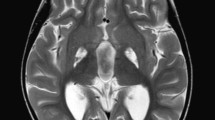Abstract
Deep brain stimulation (DBS) has been used to treat secondary dystonias caused by inborn errors of metabolism with varying degrees of effectiveness. Here we report for the first time the application of DBS as treatment for secondary dystonia in a 22-year-old male with X-linked adrenoleukodystrophy (X-ALD). The disease manifested at age 6 with ADHD, tics, and dystonic gait, and deteriorated to loss of ambulation by age 11, and speech difficulties, seizures, and characteristic adrenal insufficiency by age 16. DBS in the globus pallidus internus was commenced at age 18. However, after 25 months, no improvement in dystonia was observed (Burke–Fahn–Marsden (BFM) scores of 65.5 and 62 and disability scores of 28 and 26, pre- and post-DBS, respectively) and the DBS device was removed. Treatment with dantrolene reduced skeletal muscle tone and improved movement (Global Dystonia Rating Scores from 5 to 1 and BFM score 42). Therefore, we conclude that DBS was a safe but ineffective intervention in our case with long-standing dystonia, whereas treatment of spasticity with dantrolene did improve the movement disorder in this young man with X-ALD.
Competing interests: None declared
Access this chapter
Tax calculation will be finalised at checkout
Purchases are for personal use only
Similar content being viewed by others
References
Andrews C, Aviles-Olmos I, Hariz M, Foltynie T (2010) Which patients with dystonia benefit from deep brain stimulation? A metaregression of individual patient outcomes. J Neurol Neurosurg Psychiatry 81(12):1383–1389
Aydin S, Abuzayed B, Varlibas F et al (2011) Treatment of homocystinuria-related dystonia with deep brain stimulation: a case report. Stereotact Funct Neurosurg 89(4):210–213
Haslam RH, Walcher JR, Lietman PS, Kallman CH, Mellits ED (1974) Dantrolene sodium in children with spasticity. Arch Phys Med Rehabil 55(8):384–388
Lumsden DE, Kaminska M, Gimeno H et al (2013) Proportion of life lived with dystonia inversely correlates with response to pallidal deep brain stimulation in both primary and secondary childhood dystonia. Dev Med Child Neurol 55(6):567–574
Raymond GV, Seidman R, Monteith TS et al (2010) Head trauma can initiate the onset of adreno-leukodystrophy. J Neurol Sci 290(1–2):70–74
Vidailhet M, Vercueil L, Houeto JL et al (2005) Bilateral deep brain stimulation of the globus pallidus in primary generalized dystonia. N Engl J Med 352(5):459–467
Acknowledgments
We are grateful to Mr. Bryan Sayson for administrative assistance.
Author information
Authors and Affiliations
Corresponding author
Editor information
Editors and Affiliations
Additional information
Communicated by: Jutta Gaertner
Appendices
Synopsis
Deep brain stimulation was a safe but ineffective intervention for long-standing dystonia in X-ALD, whereas treatment with dantrolene improved movement and dystonia symptoms at the level of skeletal muscle.
Compliance with Ethics Guidelines
Conflict of Interest
Christopher Honey has received consulting fees from Medtronic, a commercial company that fabricates DBS instruments. The authors Clara van Karnebeek, Gabriella Horvath, Tyler Murphy, Jacqueline Purtzki, Kristin Bowden, Sandra Sirrs, and Sylvia Stockler have no conflict of interest to declare.
Informed Consent
All procedures followed were in accordance with the ethical standards of the responsible committee on human experimentation (institutional and national) and with the Helsinki Declaration of 1975, as revised in 2000 (5). The patient provided informed consent for publication of this report.
Ethics
The institutional review board at BC Children’s Hospital and the University of British Columbia approved the study protocol [H12-00067], and parents provided written consent for publication.
Details of Contributions of Individual Authors
CvK: Clinical biochemical geneticist who was responsible for organization of multidisciplinary meetings to discuss patient treatment and follow-up, data collection, and drafting of the first manuscript with subsequent coordination of authors’ edits.
GH: Clinical biochemical geneticist currently following patient in the Adult Metabolic Clinic, responsible for the symptomatic management with dantrolene, and reviewed/edited the manuscript.
TM: Medical student who contributed to data collection and drafting of the manuscript.
JP: Physiatrist who performed pre- and post-DBS functional evaluation, and reviewed/edited the manuscript.
KB: Technical writer who provided critical revision of the manuscript.
SSirrs: Metabolic diseases specialist who managed and followed the patients in the Adult clinic around the time of DBS: Contributed to data collection, and reviewed/edited the manuscript.
SStockler: Neurometabolic diseases specialist who was responsible for the conception of the case report, contributed to data collection, and reviewed/edited the manuscript.
CRH: Neurosurgical consultant who coordinated surgery and DBS follow-up care, and reviewed/edited the manuscript.
Rights and permissions
Copyright information
© 2014 SSIEM and Springer-Verlag Berlin Heidelberg
About this chapter
Cite this chapter
van Karnebeek, C. et al. (2014). Deep Brain Stimulation and Dantrolene for Secondary Dystonia in X-Linked Adrenoleukodystrophy. In: Zschocke, J., Gibson, K., Brown, G., Morava, E., Peters, V. (eds) JIMD Reports, Volume 15. JIMD Reports, vol 15. Springer, Berlin, Heidelberg. https://doi.org/10.1007/8904_2014_305
Download citation
DOI: https://doi.org/10.1007/8904_2014_305
Received:
Revised:
Accepted:
Published:
Publisher Name: Springer, Berlin, Heidelberg
Print ISBN: 978-3-662-43750-6
Online ISBN: 978-3-662-43751-3
eBook Packages: MedicineMedicine (R0)




